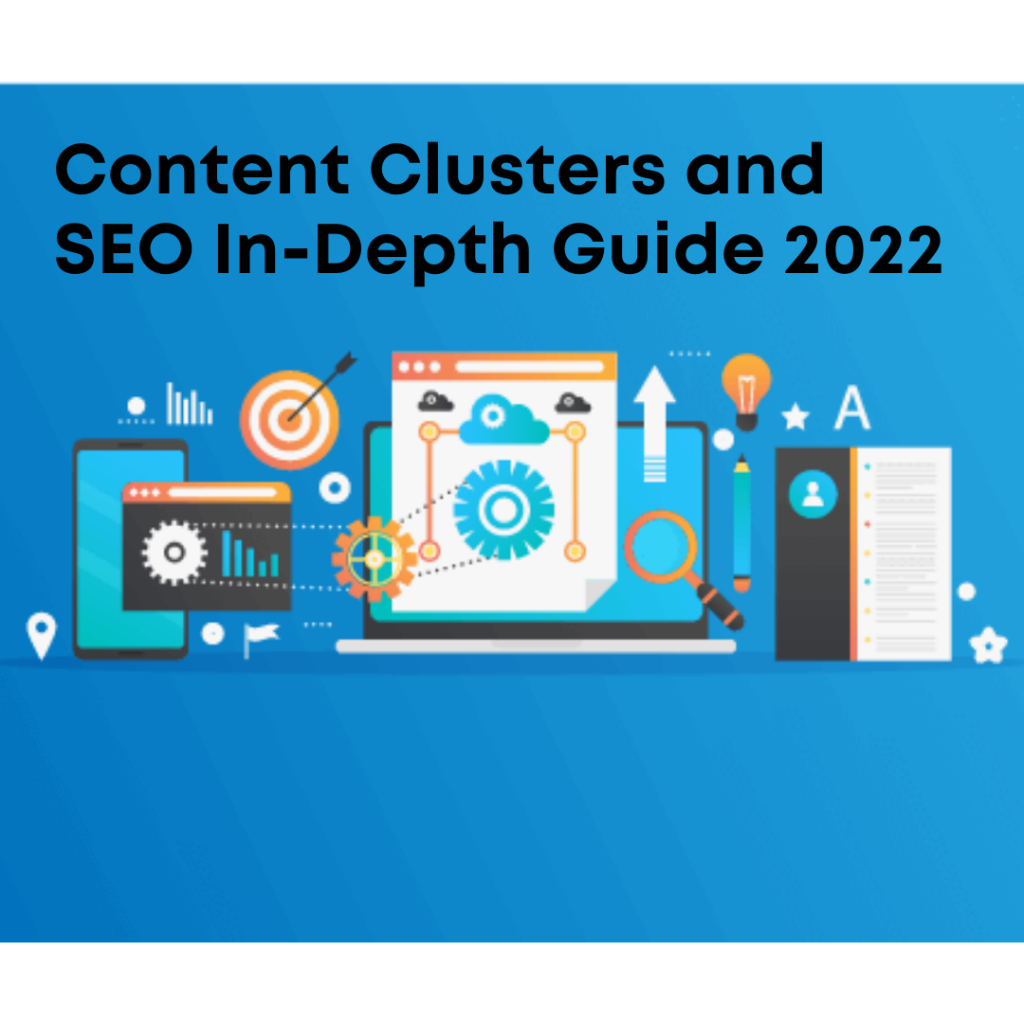According to HubSpot, 75% of people never scroll past the first page of search engines. Many companies are availing various SEO services to help them rank higher on Google.
First things first, SEO or search engine optimization is optimizing a website to raise the quality and quantity of traffic through non-paid search engine results. You can utilize several SEO tactics in your content strategies to revise and improve your SEO website audit. One such effective and proven tactic you can use is content clusters.
 This blog will give you all information you need to know about content clusters that complement your website’s search engine optimization. The blog will give you insights on how content clusters came into being, what SEO content clusters are, why you should use them for your website, and how you can create an SEO content cluster.
This blog will give you all information you need to know about content clusters that complement your website’s search engine optimization. The blog will give you insights on how content clusters came into being, what SEO content clusters are, why you should use them for your website, and how you can create an SEO content cluster.
The Story of SEO Content Clusters
If you go back to a few years, when there were no Siri and Alexa, you might remember typing out keyword queries on search engines to discover answers to your questions. Trends of search patterns have changed, and people today ask advanced queries to search engines for precise and rapid responses.
Many people use different terms in their searches, and as technology advances, search engines are becoming more adept at recognizing connections between probes. Algorithms have moved to the point where they can grasp your topical search intent, relate it to your previous searches, and return websites that best answer your query.
With the Hummingbird upgrade in 2013, Google’s search algorithm began processing sentences rather than just keywords. The RankBrain upgrade was developed in 2015, and it was aimed to grasp the context of your search queries using Google’s machine learning algorithm. To discover the best results, it links previous searches with similar themes and retrieves various keywords and phrases linked with the search query.
HubSpot conducted topic cluster trials for a selected set of topics in 2016 due to these algorithm adjustments. According to their findings, the more interlinking they did, the better placement of pages in search engine results. The number of links they established also increased impressions or page views.
Now, topic clusters are among the newest and most effective approaches to boost your content marketing strategy.
What are Content Clusters?
Before diving into more about cluster content, you first need to understand pillar pages. A website page that gives a thorough overview of a topic is called a pillar page.
A content cluster is a group of related articles and web pages focusing on a single overarching theme. Topic cluster content links to the pillar page, while the pillar page links to the topic cluster content.
On-page SEO factors such as the page title, URL, subheadings, paragraphs, and sentences are used by Google to extract meaning. The elements on the pages that connect to your content and the anchor text of those links provide additional information to Google.
Search engines use content clusters to grasp each page’s context, linkages, and structure within a content collection. In short, the supporting content that you create around your pillar pages is referred to as cluster content.
Why should you use SEO Content Clusters?
Content clusters are very important tactics that a marketer uses to rank websites higher on search engines. Here are a few reasons that could convince you why you should use SEO content clusters for your website:
Improves Keyword Optimization
Content clusters help you boost your website’s keyword SEO. You may target a broader range of keywords and phrases with pillar pages and cluster pages since they allow you to divide down a broad topic into fewer subtopics.
Having keyword variations built around the core keyword enhances your total keyword usage, which can help your website appear in search engine results when someone searches for that phrase.
Improves Sales
You can convert a customer who visits your website to conversion with a well-designed content cluster. This means you direct them to more precise information and finally bring them to a place where they can purchase your services or products, send you a message, fill out a form, or phone you for further details. This sales funnel strategy can even be spread out over numerous pages to avoid the sale lead-up feeling forced.
Enhance User Experience and Gain Backlinks
You may produce high-quality content for your website by creating content clusters. Rather than creating a single webpage, you can break down content, which improves the user experience for your website visitors.
This also allows you to go deeper into particular content and add more with time. The better and more complete your material is, you will become an authoritative resource, which can help your website obtain backlinks.
How can you create an SEO Content Cluster?
Creating content clusters may appear complex, but it is actually relatively straightforward. Here is a simple step-by-step process of creating an SEO Content Cluster for your website.
Buyer Persona
Buyer Personas are important for all types of businesses in all sectors. You can personalize your communications and strategies to your buyer personas, which allows them to address specific pain points better and provide the appropriate solutions.
Determine the most pressing issues and concerns that your customers have. You can easily develop content that draws the interest of your buyer persona if you know clearly who your audience is.
Researching Relevant Keywords
After identifying your target audience and developing a Buyers Persona, do keyword research. While researching keywords, it is essential to consider the volume of searches and keyword density. Broader keyword topics aligned to your niche will help you gain a higher rank on the search engines.
Content Creation
Now comes the content. Make a list of content ideas that are related to the keywords. Cluster pages are those to which the content of other pillar pages will be linked.
You can create an ebook, infographic, white page, or easily downloadable offers by combining numerous topics. Rather than producing leads, they should be designed to convert them.
Plan subtopics and develop content around them after you’ve created cluster pages. Make sure your keywords and content address a wide range of topics.
Cover all subtopics connected to the major keywords when writing content for pillar pages because you never know what problem your audience will be dealing with. You can interlink CTAs to create a powerful online presence.
Optimizing Content
When you have completed creating content for your pillar and cluster pages, you need to connect everything. To continue, make sure that all pillar pages contain a link to your cluster content.
By adding hyperlinks and linking one page to the next, you may make your pages more search engine friendly. More pillar pages and links to the cluster topic can be included if you publish more blog articles. This way, your content is optimized.
Monitoring Content
Analyze the entire cluster to find out how well your work is performing. Ranking, lead creation, backlinks, and engagement are some of the factors that you should consider while monitoring your page performance.
You will be able to decide which topic clusters are most advantageous to your niche and which ones you may need to eliminate after doing so.
Does your website or business require content clusters?
Implementing a content cluster strategy is a great option if you often post new blogs or already have large content archives. It will help you refine both your current and future content.
Before launching a dedicated content marketing campaign, it is better to plan out a content cluster strategy to ensure your content aligns with your business objectives.
How can you make maximum use of SEO Content Cluster Strategy?
Here are a few tips that may be useful for you while utilizing SEO cluster content strategy:
Remove Unwanted Content
Content clusters are complex and interconnected site networks centred on the same keywords and subjects. Having too much content, on the other hand, can cause issues.
If you want to have a solid content strategy, you’ll have to get rid of old, redundant, or contradicting information. These kinds of content tend to take up valuable real estate on your page while also lowering its credibility.
Utilize it for underperforming pages
Content clusters can also boost content that is not performing well. You can utilize them to send blog readers and site visitors to underperforming or unnoticed pages. This applies to a variety of platforms and websites.
- Interlink within your website pages
Content clusters assist you in structuring your website and grouping topics by interlinking content that revolves around a similar pillar or theme. You can present viewers with an ordered list of keywords categorized by a blog page, topic cluster, and site category after you start organizing your content.
Interrelated themes and keywords work together to ensure your consumer’s knowledge of the topic and how they engage with the content. The full potential of cluster themes can only be realized if the ideas and topics are expertly related.
Wrapping Up
The higher the quality of the content clusters, the easier it is to comprehend the topic. When done correctly, content clusters can help a page’s SEO results and how consumers perceive topics related to your brand and niche. This will be a great way to improve your SEO website audit over time.






